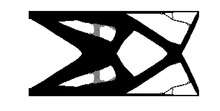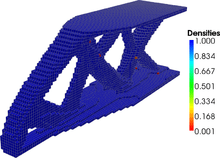Topology optimization
Topology optimization (TO) is a mathematical method that optimizes material layout within a given design space, for a given set of loads, boundary conditions and constraints with the goal of maximizing the performance of the system. TO is different from shape optimization and sizing optimization in the sense that the design can attain any shape within the design space, instead of dealing with predefined configurations.
The conventional TO formulation uses a finite element method [FEM] to evaluate the design performance. The design is optimized using either gradient-based mathematical programming techniques such as the optimality criteria algorithm and the method of moving asymptotes or non gradient-based algorithms such as genetic algorithms.
Topology Optimization has a wide range of applications in aerospace, mechanical, bio-chemical and civil engineering. Currently, engineers mostly use TO at the concept level of a design process. Due to the free forms that naturally occur, the result is often difficult to manufacture. For that reason the result emerging from TO is often fine-tuned for manufacturability. Adding constraints to the formulation in order to increase the manufacturability is an active field of research. In some cases results from TO can be directly manufactured using additive manufacturing; TO is thus a key part of design for additive manufacturing.
Problem statement
A topology optimization problem can be written in the general form of an optimization problem as:
The problem statement includes the following:
- An objective function . This function represents the quantity that is being minimized for best performance. The most common objective function is compliance, where minimizing compliance leads to maximizing the stiffness of a structure.
- The material distribution as a problem variable. This is described by the density of the material at each location . Material is either present, indicated by a 1, or absent, indicated by a 0.
- The design space . This indicates the allowable volume within which the design can exist. Assembly and packaging requirements, human and tool accessibility are some of the factors that need to be considered in identifying this space . With the definition of the design space, regions or components in the model that cannot be modified during the course of the optimization are considered as non-design regions.
- constraints a characteristic that the solution must satisfy. Examples are the maximum amount of material to be distributed (volume constraint) or maximum stress values.
Evaluating often includes solving a differential equation. This is most commonly done using the finite element method since these equations do not have a known analytical solution.
Implementation methodologies
There are various implementation methodologies that have been used to solve TO problems.
Discrete
Solving TO problems in a discrete sense is done by discretizing the design domain into finite elements. The material densities inside these elements are then treated as the problem variables. In this case material density of one indicates the presence of material, while zero indicates an absence of material. Due to the attainable topological complexity of the design being dependent of the amount of elements, a large amount is preferred. Large amount of finite elements increase the attainable topological complexity, but come at a cost. Firstly, solving the FEM system becomes more expensive. Secondly, algorithms that can handle a large amount (several thousands of elements is not uncommon) of discrete variables with multiple constraints are unavailable. Moreover, they are impractically sensitive to parameter variations.[1] In literature problems with up to 30000 variables have been reported [2]
Solving the problem with continuous variables
The earlier stated complexities with solving TO problems using binary variables has caused the community to search for other options. One is the modelling of the densities with continuous variables. The material densities can now also attain values between zero and one. Gradient based algorithms that handle large amounts of continuous variables and multiple constraints are available. But the material properties have to be modelled in a continuous setting. This is done through interpolation. One of the most implemented interpolation methodologies is the SIMP method (Solid Isotropic Material with Penalisation [3]).[4] This interpolation is essentially a power law . It interpolates the Young's modulus of the material to the scalar selection field. The value of the penalisation parameter is generally taken between . This has been shown to confirm the micro-structure of the materials.[5] In the SIMP method a lower bound on the Young's modulus is added, , to make sure the derivatives of the objective function are non-zero when the density becomes zero. The higher the penalisation factor, the more SIMP penalises the algorithm in the use of non-binary densities. Unfortunately, the penalisation parameter also introduces non-convexities [6]).
Commercial Software
There are several commercial topology optimization software on the market. Most of them use topology optimization as a hint how the optimal design should look like, and manual geometry re-construction is required. There are a few solutions which produce optimal designs ready for Additive Manufacturing.
Examples



Structural compliance
A stiff structure is one that has the least possible displacement when given certain set of boundary conditions. A global measure of the displacements is the strain energy (also called compliance) of the structure under the prescribed boundary conditions. The lower the strain energy the higher the stiffness of the structure. So, the problem statement involves the objective functional of the strain energy which has to be minimized.
On a broad level, one can visualize that the more the material, the less the deflection as there will be more material to resist the loads. So, the optimization requires an opposing constraint, the volume constraint . This is in reality a cost factor, as we would not want to spend a lot of money on the material. To obtain the total material utilized, an integration of the selection field over the volume can be done.
Finally the elasticity governing differential equations are plugged in so as to get the final problem statement.
subject to:
But, a straightforward implementation in the Finite Element Framework of such a problem is still infeasible owing to issues such as:
- Mesh dependency—Mesh Dependency means that the design obtained on one mesh is not the one that will be obtained on another mesh. The features of the design become more intricate as the mesh gets refined.
- Numerical instabilities—The selection of region in the form of a chess board.
Some techniques such as Filtering based on Image Processing are currently being used to alleviate some of these issues.
3F3D Form Follows Force 3D Printing
The current proliferation of 3D Printer technology has allowed designers and engineers to take advantage of topology optimization techniques when designing new products.
Topology Optimization combined with 3D Printing allows significant lightweighting, improved structural performance and shortened design-to-manufacturing cycle.
Multiphysics problems
References
- ↑ Sigmund, O., Maute, K., Topology optimization approaches A comparative review. Structural and Multidisciplinary Optimization, 2013, p. 1031-1055
- ↑ Beckers, M. Topology optimization using a dual method with discrete variables. Structural Optimization, p. 14-24
- ↑ Bendsøe, MP. Optimal shape design as a material distribution problem.. Structural Optimization, 1989, p. 193-202
- ↑ , a monograph of the subject.
- ↑ , A reference that proved the validity of the interpolation scheme.
- ↑ van Dijk, NP. Langelaar, M. van Keulen, F. Critical study of design parameterization in topology optimization; The influence of design parameterization on local minima.. 2nd International Conference on Engineering Optimization, 2010
- An efficient 3D topology optimization code written in Matlab K. Liu and A. Tovar; Int Journal of Structural and Multidisciplinary Optimization, doi:10.1007/s00158-014-1107-x, available from http://top3dapp.com
- Investigation into Structural Topology Optimization Problem Formulations, William Renold, lulu.com, 2007.
- Recent Developments in the Commercial Implementation of Topology Optimization; Uwe Schramm, Ming Zhou; IUTAM Symposium on Topological Design Optimization of Structures, Machines and Materials: Status and Perspectives, 239–248; 2006 Springer.
- Industrial Implementation and Applications of Topology Optimization and Future Needs; Claus B.W. Pedersen; Peter Allinger; IUTAM Symposium on Topological Design Optimization of Structures, Machines and Materials, 229-238; 2006 Springer.
- A 99 line topology optimization code written in Matlab Ole Sigmund; Int Journal of Structural and Multidisciplinary Optimization, Volume 21, 120-127, 2001 Springer
- Topology optimization of 2D continua for minimum compliance using parallel computing Arash Mahdavi; Balaji Raghavan; Mary Frecker; Int Journal of Structural and Multidisciplinary Optimization, Volume 32, 121-132, 2006 Springer
- Modern Structural Optimization Concepts Applied to Topology Optimization Juan Pablo Leiva; Brian C. Watson and Iku Kosaka ; 40th AIAA/ASME/ASCE/AHS/ASC Structures, Structural Dynamics, and Material Conference. St. Louis, MO, pp. 1589–1596, 1999
- ToPy, an open source topology optimization program written in Python.
External links
- - page containing information on the SIMP optimization method.
- Topology optimization animations